- BOAT OF THE YEAR
- Newsletters
- Sailboat Reviews
- Boating Safety
- Sailing Totem
- Charter Resources
- Destinations
- Galley Recipes
- Living Aboard
- Sails and Rigging
- Maintenance
- Best Marine Electronics & Technology


Sailboat Engine Replacement Options
- By Ed Sherman
- Updated: June 16, 2020
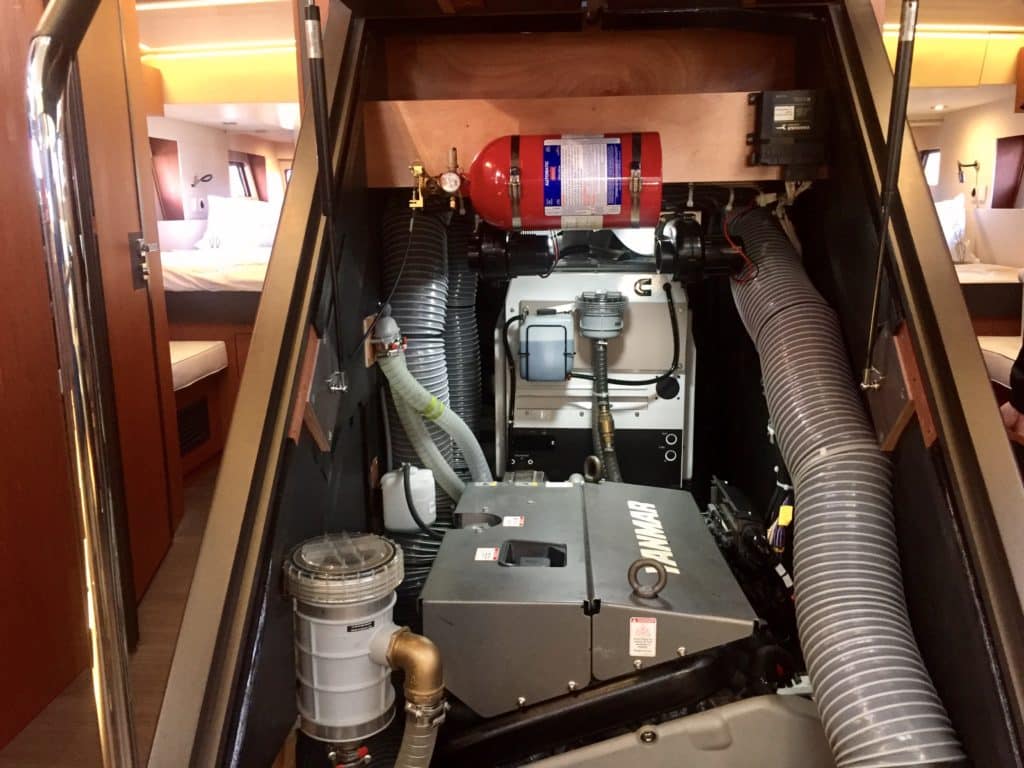
It’s the end of another sailing season, and as you haul the boat and begin its winter layup, you have reminders aplenty that the 30-year-old auxiliary engine is getting tired. The intermittent no-start condition, oil and coolant leaks, and excessive smelly exhaust smoke are finally getting to you. As you prepare to change the oil and run some antifreeze through the block, it occurs to you that it might be time for an upgrade. What should you consider? What are your choices? What are the pitfalls? Follow along and we’ll set you straight.
First off, if your sailboat’s auxiliary engine is truly approaching its third decade (or older), you need to understand that there may be significant components besides the engine that are probably going to need replacement. Things like the exhaust system, primary engine wiring harness, instrumentation, engine- and transmission-control cables, fuel tanks, transmission, shaft, cutlass bearing and prop are all suspect and need to be carefully evaluated. When looking at your options, be sure to factor all these additional items into your budget projection. Your new engine is just a part of the big picture.
Need More Power?
Back in the 1970s and ’80s, a lot of new sailboats were produced with engines that, frankly, were a bit underpowered. I know; I owned one. It was fine until I hit a head-on current in a narrow channel; I clearly remember moving along at a half-knot under full power. This scenario repeated itself all too frequently in some of the other New England waters I cruised regularly. More get-up-and-go would have been greatly appreciated.
So if you’ve experienced similar frustration, now is the time to consider more horsepower. How much is enough? You’ll need to do a bit of research to determine the best possible choice.
Consider that a sailboat is just like an airplane that stays at sea level. Power-to-weight ratios do matter: The heavier the plane’s engines, the more thrust it needs to gain altitude. The whole idea is to find the ideal balance. Simply replacing your 25- or 30-horsepower auxiliary engine with a 75-horsepower turbocharged model might sound good, but there’s more to consider than pure muscle.
First off, the 75-horsepower engine might simply be too heavy for your boat. Next, since most cruising sailboats have displacement hulls, things like waterline length and actual weight count considerably, just as they do for airplanes. With a full-displacement hull form, you can squeeze only so much speed out of that waterline length. Adding more horsepower represents a significant economic waste.
RELATED: Monthly Maintenance: Getting Back Aboard
Besides weight, physical dimensions are of paramount importance. Is it possible to get a motor-mount configuration that will work with your choice of marine diesel engine and the existing engine bed in the boat? What about service-point access? The water-pump impeller might appear to be easily replaceable on your new engine when you look at it at the boat show, but what about when it’s been bolted into place? There’s nothing worse than an engine part you simply can’t reach when you need to in a hurry. And will your engine-room space require additional modifications to fit a new muffler, filter location, shaft coupler, etc.?
Remember that marine diesel engines require a considerable amount of fresh air to run properly. Especially if you plan to increase horsepower, you may need to add engine-room ventilation to keep that new power plant from suffocating.
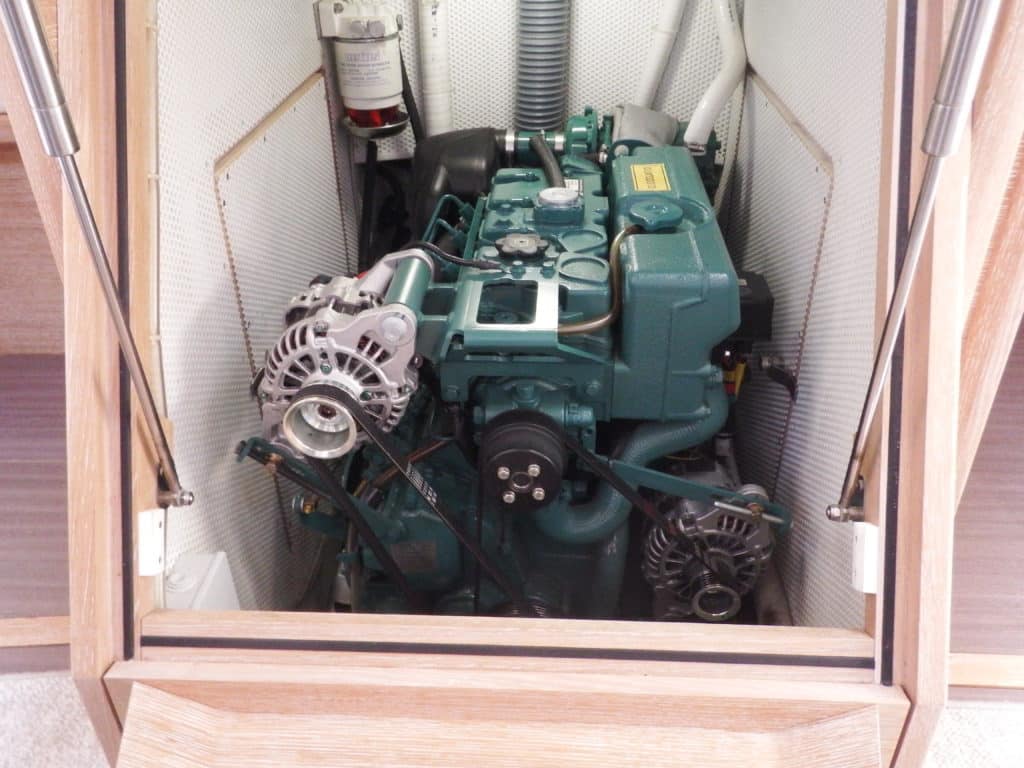
Common-Rail Marine Diesel Engines
In recent years here in the States, officials at the Environmental Protection Agency, along with their counterparts in Europe, have been working hard to create regulations that do two things: clean up diesel fuel by reducing sulfur content significantly, and eliminate emissions from the diesel combustion process.
EPA mandates now require what are described as “Tier 3” emissions standards for boats sold in the U.S., regardless of where they are made. The effect of this became evident this past fall, when I was one of the judges for Cruising World ’s Boat of the Year competition. Of the 24 boats we tested and compared, half were equipped with electronically controlled “common-rail” super-high-pressure fuel-injection systems. The new diesels use a common chamber that is often, but not always, integrated into the engine’s cylinder head, and which holds fuel for all the cylinders in the engine. The fuel is pressurized by a pump that operates at much higher pounds-per-square-inch than those used in older systems, which sent fuel from the fuel pump directly to individual fuel injectors at each cylinder.
In older marine diesel engines, fuel pressure typically ranged from a low of about 1,500 psi to close to 4,000 psi. In these systems, the injectors opened when fuel was compressed to what is referred to as the injector “pop” pressure.
In common-rail diesel engines, injectors are still used, but the pressure in the rail chamber is on the order of 15,000 psi to 20,000 psi. Injectors, meanwhile, are controlled by electronic solenoid valves, whose opening and closing time is controlled by an onboard CPU that adjusts the duration of each burst of fuel based on data inputs like temperature, engine load and rpm.
Here’s the good news: You’ll never have to bleed air out of these systems, as they are completely self-bleeding. With older marine diesels, bleeding was a fairly common task required after fuel-filter changes or running out of fuel. This problem is simply eliminated with the common rail. All that’s needed is to crank the engine, and the high-pressure pump will take care of the rest. Now here’s the bad news: The biggest fear with these engines is a problem with the onboard electronics. Rather than carrying spare fuel injectors, long-distance cruisers may now want to carry spare injectors and a spare engine-control CPU.
The hope, of course, is that the reliability of the engines will negate the need for fuel-system maintenance; routine fuel- and oil-filter changes can still be done by the owner. Problems will arise, though, when an engine doesn’t perform as it should. These are complex machines, and without the proper skills and equipment (diagnostic computers and the ability to read error codes), a boat owner probably won’t find a way to sort things out as he might have with a traditional marine diesel.
The Kiwi delivery skipper was aboard one of the boats I boarded during the boat show in Annapolis. It was a multihull, powered by a pair of common-rail diesels, and I asked the obvious question: How have these engines been, in your experience? His answer was telling. He said he was glad to have two engines on these catamarans because usually one of the two will have problems during the delivery — problems that he can’t solve. If you’re contemplating a voyage on a single-engine monohull, you would probably find that response unnerving, to say the least.
Rebuild or Replace the Auxiliary Engine?
As I stated earlier, the simple solution to your power needs may not be to replace the 25-horsepower with the beefy 75-horsepower motor. Depending on your boat and circumstances, you may still be able to get a currently compliant (EPA-wise) engine in the lower-horsepower range that still uses older technology. The dividing line at present is found at about 50 horsepower, depending on the manufacturer.
If you think you need more than that, you’re probably going to end up with an electronically controlled diesel engine with all the fixings — and a major series of modifications to your old boat will be needed to make the change.
If that’s the case, the possibility of rebuilding your existing sailboat auxiliary engine may make better economic sense, but only if the circumstances allow it. If you are merely trying to get a boat refreshed for resale within a year or so, the overhaul of your existing engine makes some sense. A rebuild typically will save several thousand dollars, compared with a full-on replacement. But you’ll only be able to enjoy a very limited warranty on the work, compared with the two- to five-year peace of mind that comes with a new marine diesel’s warranty. Further, realize that as the engine ages, parts become increasingly difficult to find; next time a repair becomes necessary, it may be impossible. If you’re planning on keeping the boat, in my view, a repower is the only intelligent solution.
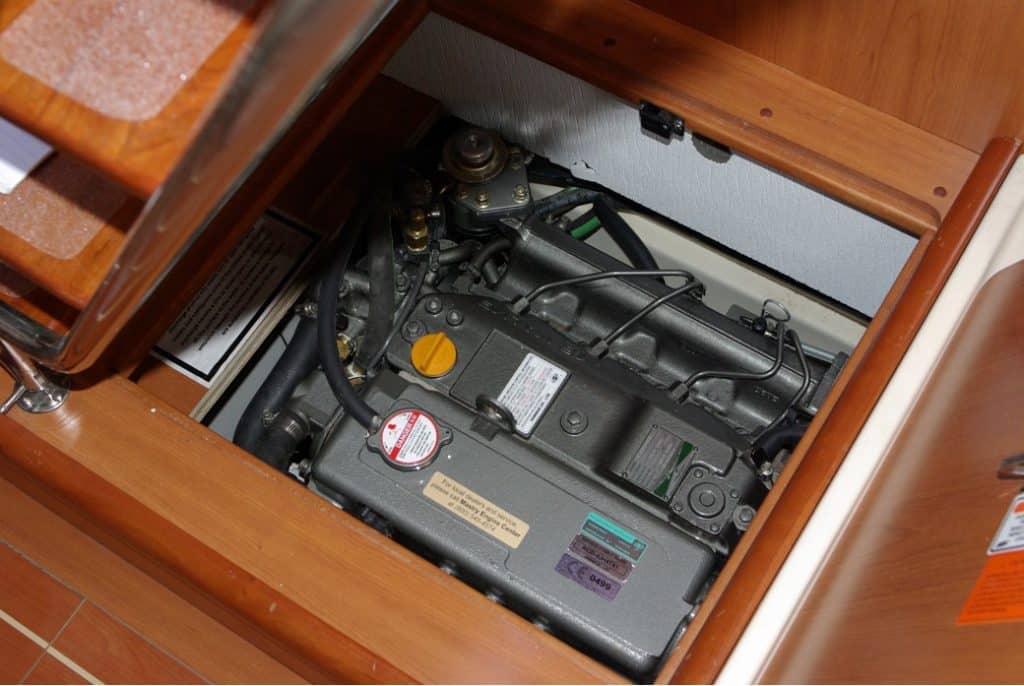
Marine Diesel Engine Comparison
A search for sailboat auxiliary diesels yields results that would indicate there are really only seven brands: Yanmar, Volvo Penta, Beta, Westerbeke, Perkins, Vetus and Nanni, with Yanmar and Volvo Penta maintaining significant market share. Of the 24 sailboats in our BOTY mix this year, 11 were powered with Yanmars and 10 with Volvo Pentas. We had one boat with twin 20-horsepower Honda outboards, one with twin Nanni diesels, and one sailboat with an electric drive. You’ll probably read in online forums that most marine diesels are made by either Kubota or Mitsubishi, but that’s not quite accurate.
Yanmar produces all of its engines, and Volvo Penta manufactures its larger ones in-house. Smaller Volvos are produced by Perkins and given a Volvo-green paint job. Understand that Perkins uses the Kubota diesel as its base engine and then marinizes it to its own specifications. Perkins, which is a subsidiary of Caterpillar, is based in the United Kingdom, but also has some distribution here in the United States.
Nanni, a French company, uses Kubota, Man, Toyota and John Deere engines as its bases, depending on the horsepower. Vetus, with very limited U.S. exposure, has used Kubota, Mitsubishi and other base engines over the years. I can remember vividly a customer of mine years ago with a Vetus that used a four-cylinder Peugeot diesel as its base.
The bottom line today is that the volume of engines produced for the marine industry is quite small by industrial standards. Globalization has made it easy for manufacturers to source base engines for marine use that might also be used in tractors, generators and other relatively small machinery in both on- and off-road applications. With that in mind, it pays to check out the dealer and distributor network from both a regional and international perspective before you make a final choice. Beta, for example, has a significant dealer and parts network here in the U.S., so if you plan on cruising locally, parts and repairs should be easy enough to find. Beta, Yanmar, Volvo Penta and Westerbeke also offer a variety of engine-mount options to accommodate the various footprints that installers may encounter.
By comparison, if you opt to go with a Nanni, here in the States at least, repairs might not be that simple. I needed no less than 30 minutes and three phone calls to the Florida distributor to find out what the U.S. warranty covers. I still don’t know. I found the Australian distributor’s website, which mentions a two-year “plus one” guarantee, but the definition of “plus one” wouldn’t upload. On sailing forums, I found quite a few folks who complained about hard-to-find and expensive parts. It seems when Nanni marinizes, say, a Kubota engine, things like air-intake filters and other common service items are proprietary, and so replacements can’t necessarily be purchased at the local Kubota tractor dealer on some remote out island. Since the company is based in Europe, service and parts may be more available there.
For those who use their boats only occasionally and close to home waters, service and parts availability may not be a big enough issue to outweigh other considerations, such as cost. But if long-distance cruising is in your plans, it pays to carefully assess service and parts availability from a global perspective.
As for your modern electronic common-rail diesel engine, if that’s the way you must go, at the very least, stick with one of the two major manufacturers, Volvo Penta or Yanmar — and even then, good luck if you get hit by lightning halfway to Tonga. You’ll be hard pressed to find a service technician in a timely fashion, so carrying spare electronic components should be a serious consideration.
And a final note: For those of you who are on the last go-round with the venerable Universal Atomic Four gasoline engine, it’s time to switch to a diesel, if for no other reason than the continued availability of parts. If you want to stick with the Universal brand, give Westerbeke a call; the company still supplies two Universal engine models — the M3-20 B and the M-25 XPB — that are bolt-in replacements for the gas units. By the way, these are both Kubota-based engines.
Ed Sherman is the vice president of the American Boat & Yacht Council and heads its education division. He is a frequent CW Boat of the Year judge.
- More: DIY Sailboat Projects , engine , engines , How To , power , Refits , systems , Upgrades
- More How To

3 Clutch Sails For Peak Performance

It’s Time to Rethink Your Ditch Kit

8 Ways to Prevent Seasickness

How To De-Winterize Your Diesel Engine

The Moorings Expands in Croatia
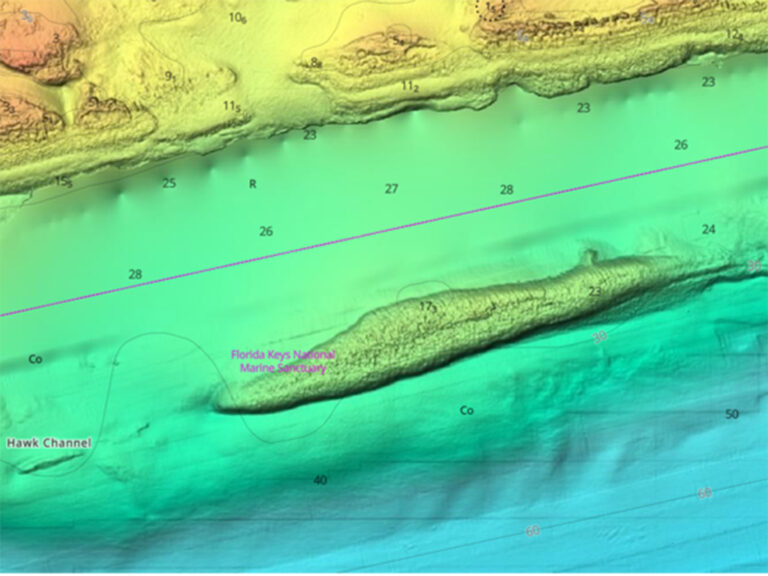
C-Map Updates North America Charts
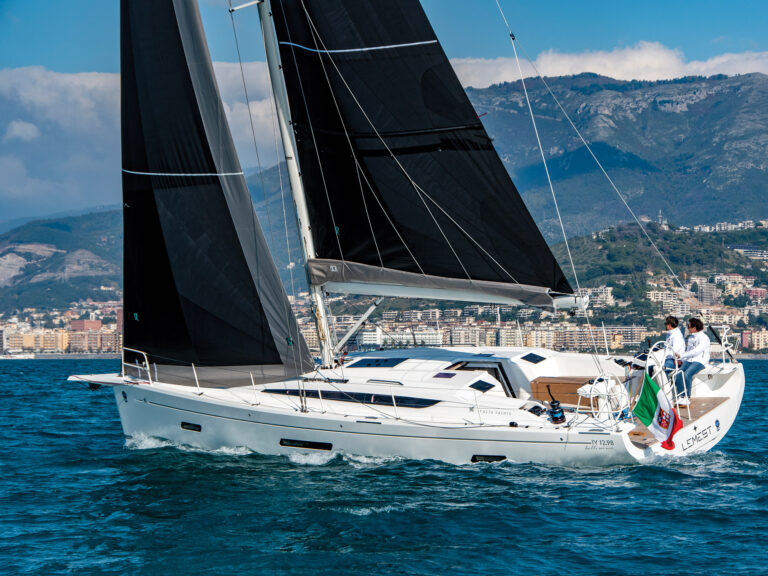
New to the Fleet: Italia Yachts 12.98
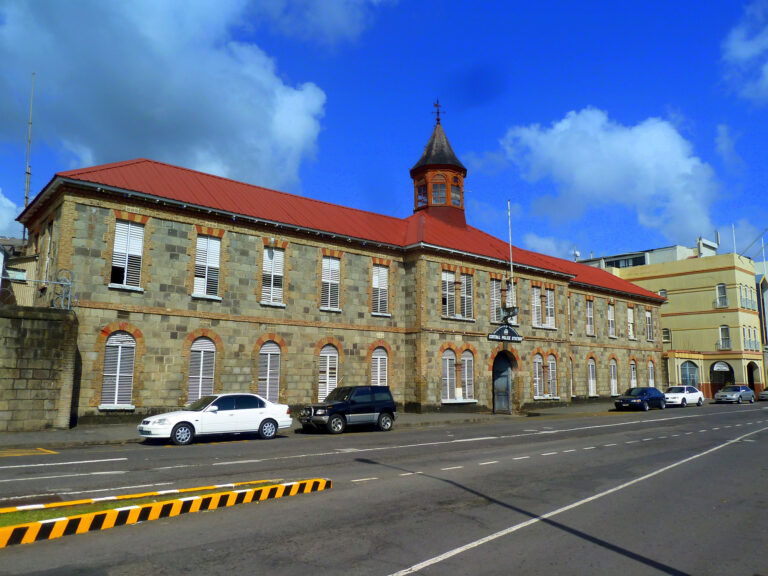
St. Vincent Court Orders Deportation For Hijacking Suspects
- Digital Edition
- Customer Service
- Privacy Policy
- Terms of Use
- Email Newsletters
- Cruising World
- Florida Travel + Life
- Sailing World
- Salt Water Sportsman
- Sport Fishing
- Wakeboarding
Many products featured on this site were editorially chosen. Cruising World may receive financial compensation for products purchased through this site.
Copyright © 2024 Cruising World. A Bonnier LLC Company . All rights reserved. Reproduction in whole or in part without permission is prohibited.
- 2024 BOAT BUYERS GUIDE
- Email Newsletters
- Boat of the Year
- 2024 Freshwater Boat and Gear Buyers Guide
- 2024 Boat Buyers Guide
- 2024 Water Sports Boat Buyers Guide
- 2023 Pontoon Boat Buyers Guide
- Cruising Boats
- Pontoon Boats
- Fishing Boats
- Personal Watercraft
- Water Sports
- Boat Walkthroughs
- What To Look For
- Best Marine Electronics & Technology
- Watersports Favorites Spring 2022
- Boating Lab
- Boating Safety

Things to Consider When Repowering With Electric Motors
- By Capt. Vincent Daniello
- August 7, 2023
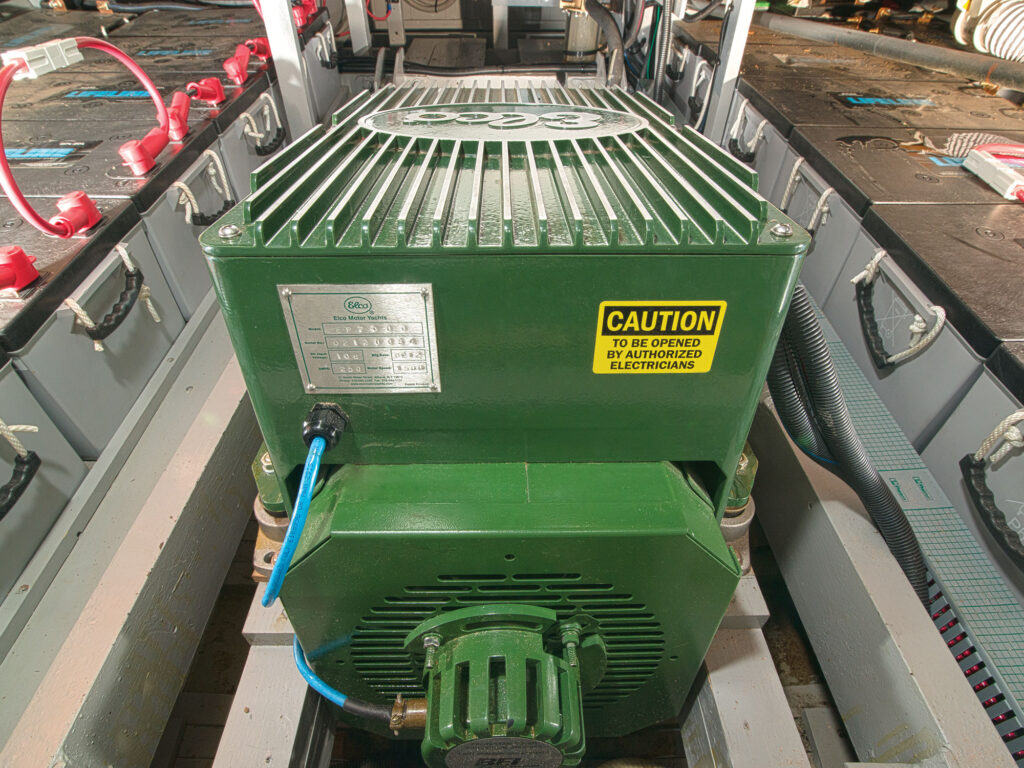
Much reporting focuses on reasons why one might choose electric marine power. The issues of range, speed, noise levels, winterizing and ethanol challenges, lake restrictions, environmental concerns and more all must be resolved on an individual basis. Little gets said about how a boater choosing to repower with electric actually gets that accomplished. Is it DIY? And if not, how does it get done?
Are you considering repowering with electric? Here’s a look at what it takes to cut the fuel line and plug in.
How Fast, How Far and How Long?
Electric propulsion can provide speed, range and runtime, but not all at once. An electric boat, motor and battery combination might top 25 mph for an hour. The same boat can also travel more than 50 miles at 6 mph, or longer still at slower speed. That makes the first step in going electric determining how far, in miles, you want to go fast, and how long, in hours, you need to go slow. Then match a motor and batteries to suit.
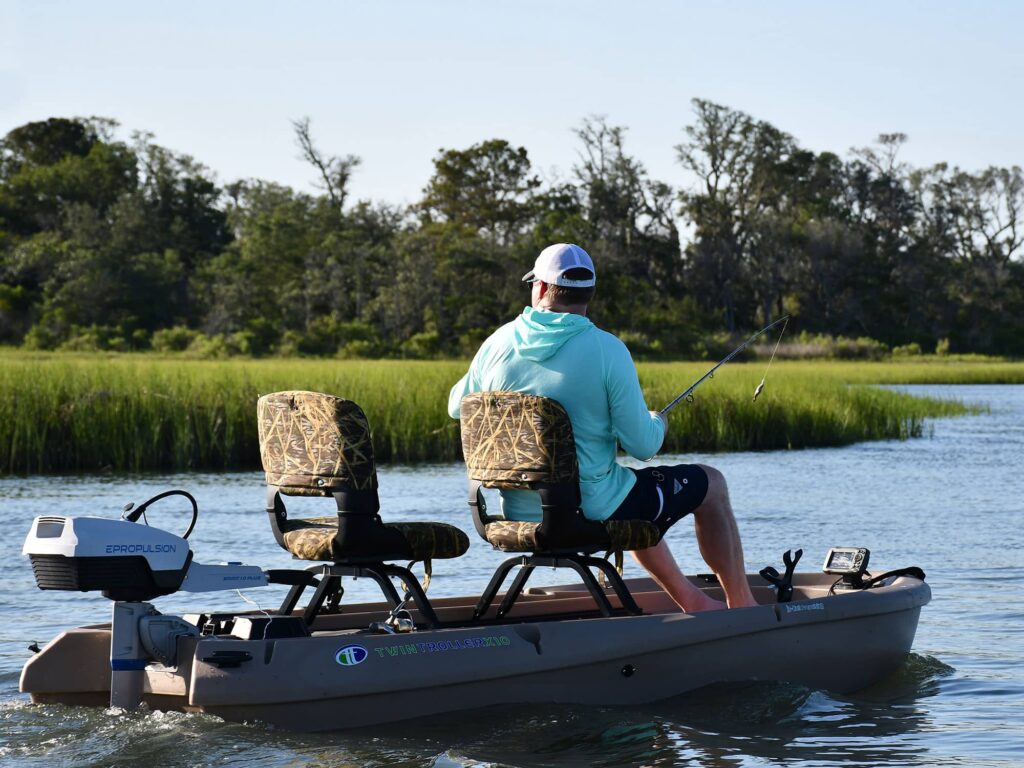
Portable Propulsion (DIY)
For small boats pushed to modest speeds, small, light options from ePropulsion , Torqeedo and Elco —equivalent to 3 hp gas outboards—easily clamp onto a transom yet store within a lazarette without worry of spilled gas. Most go for about an hour at full throttle, or 90 minutes at cruising speed, from one integrated or small external battery. These range from $2,500 to $3,500 for the motor, battery and charger.
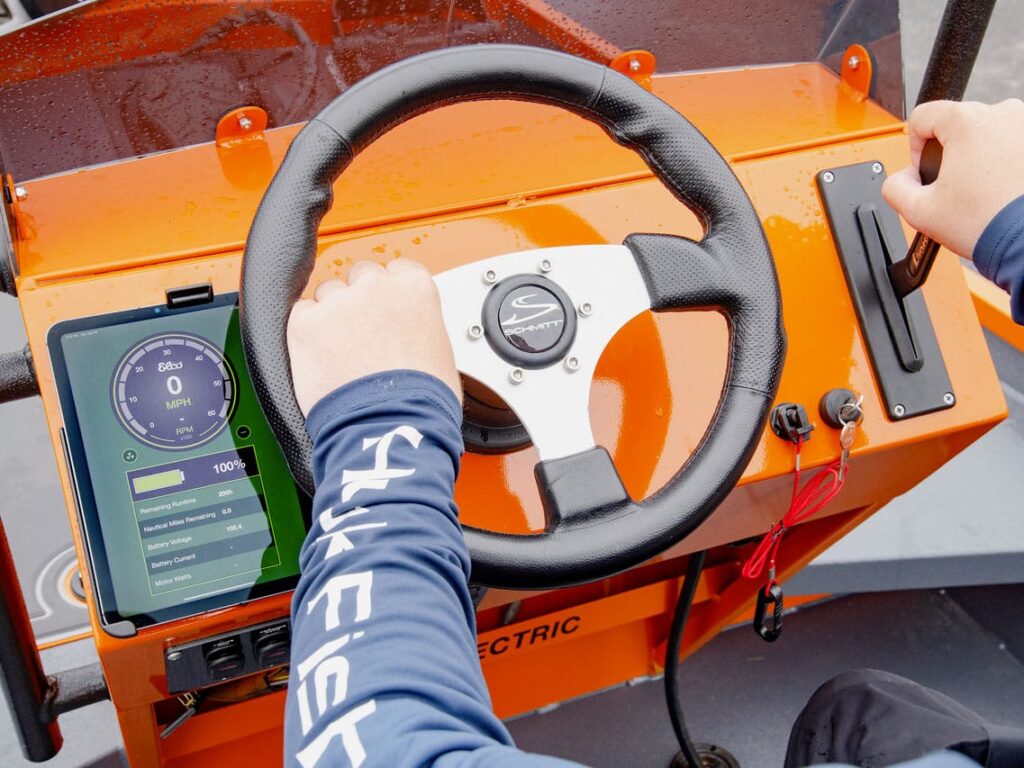
Hardwired Horsepower (DIY or Dealer)
Elco, Torqeedo, ePropulsion and Flux offer motors equivalent to gas outboards from 5 hp to 25 hp. These typically connect to fixed battery banks mounted aboard. Most companies offer self-installation packages that call upon basic mechanical skills. All facilitate turnkey installation through dealer networks. Flux eliminates DIY installation, partly because its outboards utilize higher voltages than others in this horsepower range.
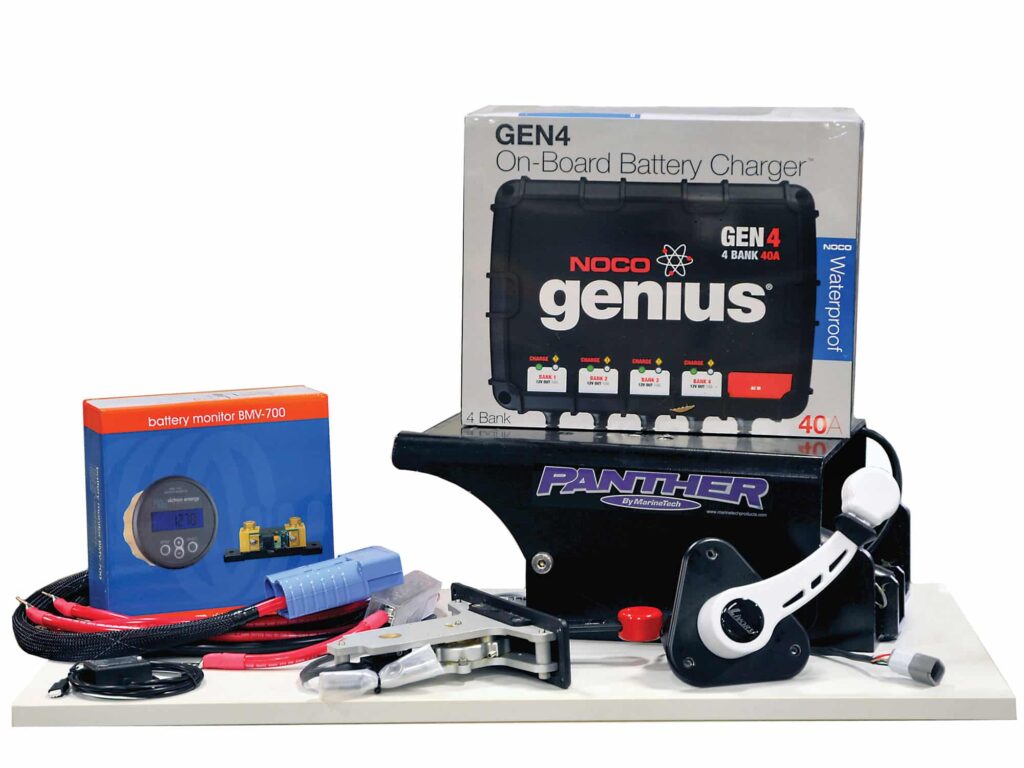
These midsize motors tend to work best for bigger boats at slower speeds. Elco, for example, says its EP-20 can push a 24-foot pontoon boat about 8 mph for two hours, while the same charge provides more than 10 hours of battery life at 5 mph; the cost is around $11,500. Just be sure to choose adequate power to dock in a breeze and then back off the throttle to extend range.
Planing Power (Dealer, Some DIY)
Elco, Torqeedo and Flux offer motors comparable to ICE outboards from 30 hp through 100 hp. Most utilize twice the operating volts compared to companies’ smaller outboards, with those added volts providing more short-term power, which is needed for the few high-load moments while boats climb fully onto plane. Only Elco facilitates DIY installation within this power range, even offering pre-made cables, equipment and accessories. The complete package propelling Rock Proof’s ePro 1760R , a boat we tested in Boating ’s March 2023 issue, utilizes Elco’s EP-50 and 20 kWh of lithium batteries; it sells for about $22,500.
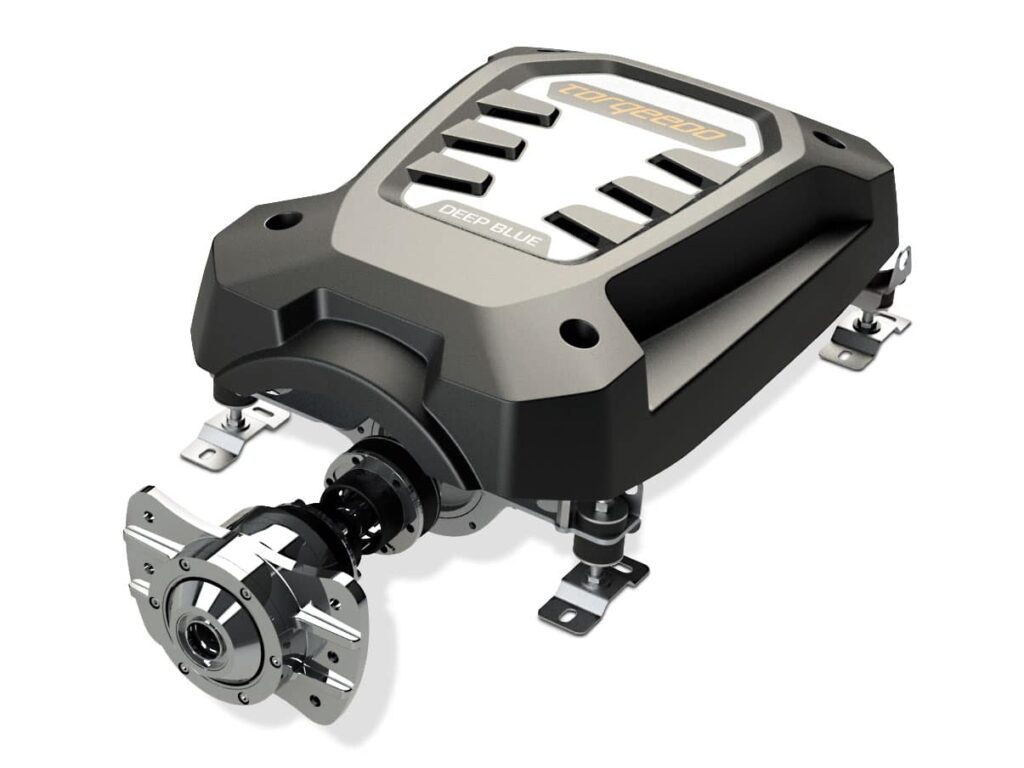
Inboard Options (Dealer, Some DIY)
While Elco has offered modern electric-propelled launches since 1987 and inboard repower options since 2009, its newest inboard motors are one-third smaller and half the weight of previous models, illustrating industry trends. Torqeedo and, recently, ePropulsion also offer powerful, light inboard motors for either repower or OEM installation. Most are intended to operate at modest speed, although Torqeedo offers three models operating at higher rpm for planing boats—its largest replaces 135 hp ICE engines while weighing one-third of a comparable ICE inboard motor and transmission (195 pounds plus batteries versus 567 pounds for a 135 hp MerCruiser 3.0 bobtail). A complete system with batteries that can run 50 minutes at full throttle costs about $120,000.
Read Next: Going Electric to Repower an Antique Boat
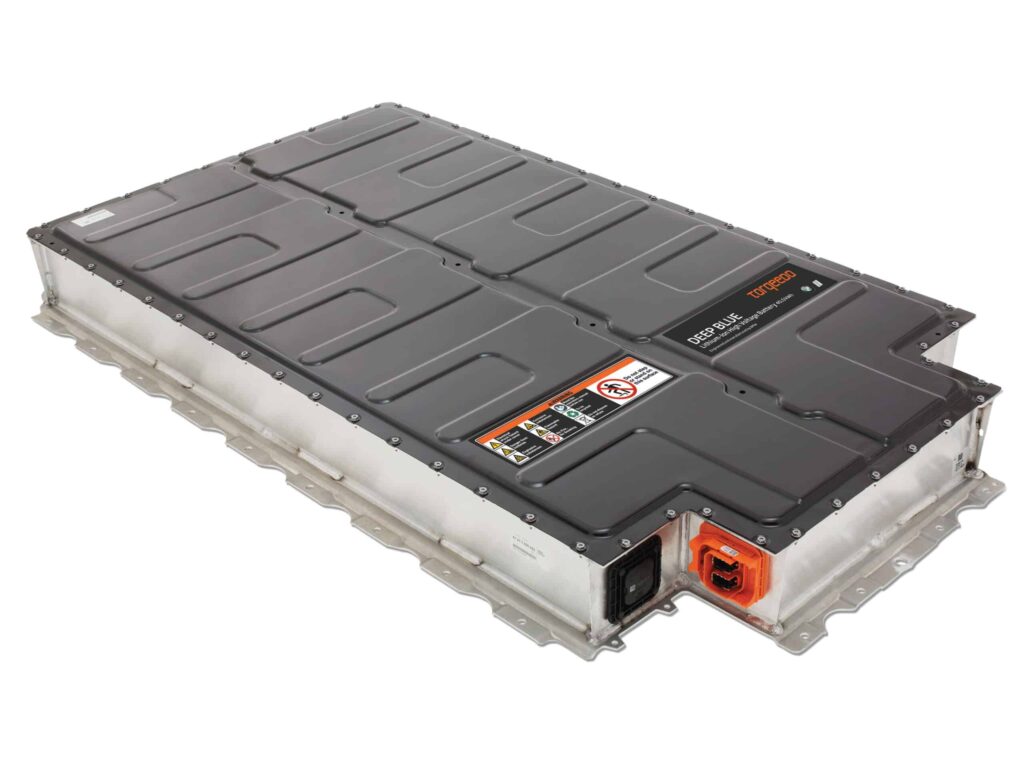
Electric motors ranging from 5 hp to 25 hp typically operate at 24 or 48 volts. This provides the broadest battery choices to balance size, weight, range and cost. All Elco and many Torqeedo motors accommodate any brand or battery type that meets specifications, adding flexibility. Absorbed glass mat (AGM) batteries , for instance, save considerable dollars compared to lithium for slow-speed boats. Larger motors, particularly when boats approach planing speed, require lithium batteries, which are half the weight yet provide higher continuous output compared to AGM.
- More: August/September 2023 , Boats , elco , electric boats , Engines , torqeedo
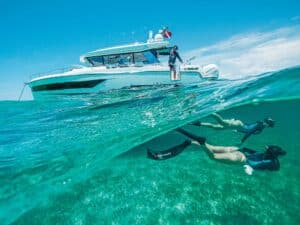
Six Boats Built for Adventure
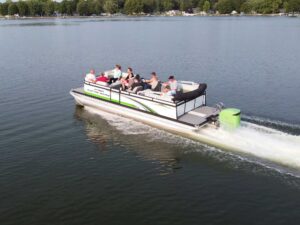
Hyper Electric Marine’s Electric-Outboard Pontoon Boat
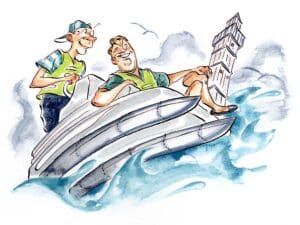
Modern Pontoons Are Built for a Variety of Boating Styles

Can a Unibody Truck Easily Tow a Boat?
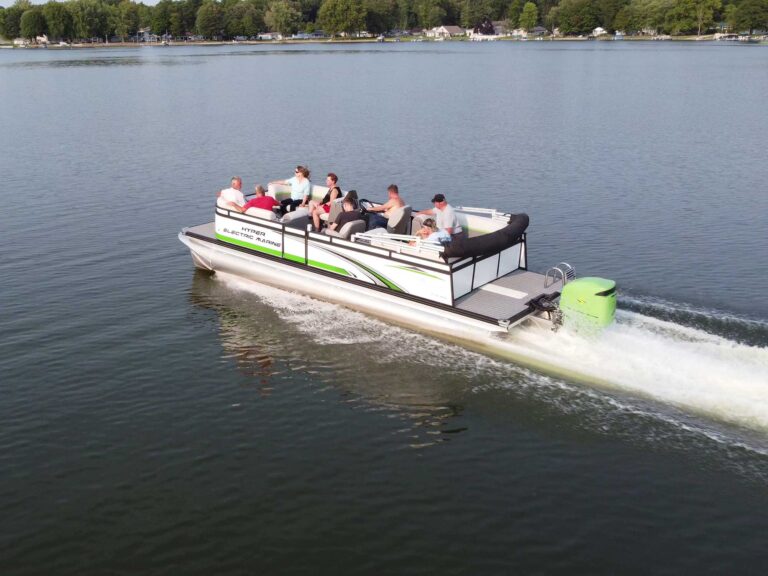
On Board With: Andrew Robbins
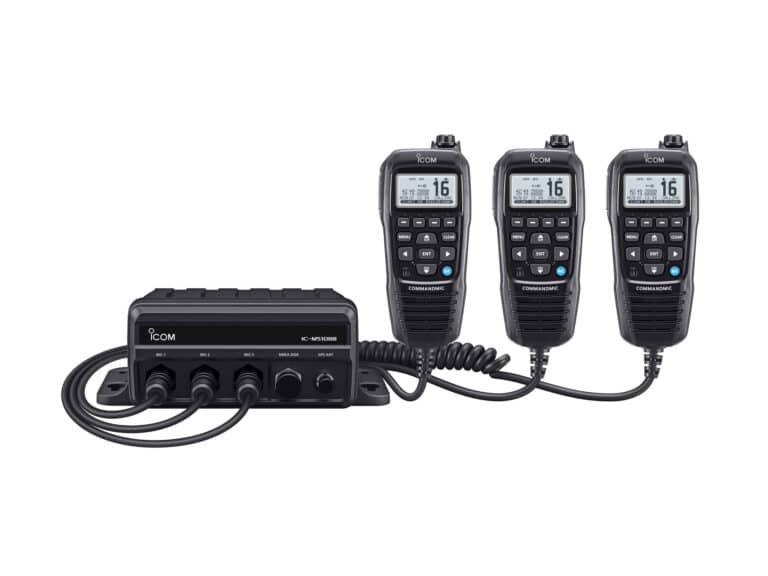
Icom IC-M510BB Black-Box VHF Radio

- Digital Edition
- Customer Service
- Privacy Policy
- Terms of Use
- Cruising World
- Florida Travel + Life
- Sailing World
- Salt Water Sportsman
- Sport Fishing
- Wakeboarding
Many products featured on this site were editorially chosen. Boating may receive financial compensation for products purchased through this site.
Copyright © 2024 Boating. A Bonnier LLC Company . All rights reserved. Reproduction in whole or in part without permission is prohibited.
Repowering a Boat: What You Should Know
Does your boat engine need to be replaced? If so, you should review the pros, cons, costs, and considerations for repowering a boat. Stay tuned to discover everything you need to know!
What Does Repowering a Boat Entail?
So, what does repowering a boat mean? This term refers to replacing your old boat engine with a newer alternative. Doing so makes your vessel faster, more efficient, and less likely to break down.
Pros of Repowering a Boat
As mentioned, repowering your boat helps it run faster and more efficiently. In addition, here are some of the benefits:
1. Improve Performance
Replacing your old engine with a new one is a phenomenal way to maximize your boat’s overall performance. Generally, repowering a boat improves the power-to-weight ratio (making your boat easier to handle), maximizes speed and power, and offers a more enjoyable boating experience overall.
2. Extend the Boat’s Lifespan
A properly-maintained boat engine lasts many years – extending your time on the water. And not only do newer engines feature advanced technology and higher-quality parts, but they allow for longer service intervals. That means they require less maintenance.
Read Next: Boat Maintenance Guide
3. Increase Resale Value
Thinking about selling your boat? (Either sooner or later?) Because the value of your boat increases when you replace your old engine with a newer, more powerful one. Generally, buyers are more interested in purchasing modern, efficient, and dependable vessels.
4. Improve Fuel Economy
We probably don’t need to remind you that gas prices are increasing. However, newer engines allow you to spend less money on gas or fuel .
5. Better for the Environment
When repowering your boat, you can upgrade to an engine that uses less fuel and meets the current carbon pollution rules. Manufacturers make the newest machines to be as green as possible . And by reducing pollution, your boat becomes safer for the environment and the seas.
Read Next: Responsible Boating Guide
Cons of Boat Repowering
Naturally, there are two sides to every coin. Here are some drawbacks of repowering:
1. Boat Downtime Needed
Depending on the vessel’s size and the work’s complexity, the repowering process takes some time (several days or weeks.) Because you can’t operate your boat during that time, you must plan your schedule accordingly.
2. Compatibility
Believe it or not, certain engines aren’t compatible with certain types of boats. Therefore, you must verify that your fuel and exhaust systems, buttons, gauges, and electrical links work with the new engine. And note that the price might increase depending on any necessary changes.
3. Installation
Usually, you’ll need to hire professional marine technicians to handle a project of this size. They can verify that everything was done correctly and that the installation is successful. However, their expertise comes with a price, and hiring experts bumps the overall cost.
4. Repowering Costs
So, how much does it cost to repower a boat? Typically, upgrading your boat’s power source costs several thousand dollars. However, your exact price depends on factors like boat size, engine type, installation fees, boat modifications, and additional equipment.
Our advice? Do your research and collect quotes from multiple sources. That way, you can thoroughly assess your options and select the one that works best for you.
What to Consider:
Decided that it’s time to repower your boat? Before you do, there are a few considerations to keep in mind:
- Maintenance : There’s no getting around it – new engines require ongoing maintenance! When factoring this into your decision, consider the proximity of repair shops, what the warranty includes, and how easy it is to reach customer service.
- R egulations and emissions standards: Every boater must adhere to the local regulations and emissions standards. To avoid legal problems, your new engine must comply with laws regarding engine pollution, noise levels, and environmental concerns.
- Compatibility: It’s important to remember that certain engine types aren’t compatible with certain boat models. And just because someone suggests an engine model doesn’t mean it will automatically work for you.
The Bottom Line
The benefits far outweigh the cost of repowering your boat. And if you’ve decided to upgrade your boat’s power system, we hope this guide answers your questions.
On the Discover Boating Blog, you'll find boating advice, maintenance guides, and buying tips for both seasoned pros and first-time boaters. If you’re interested in learning how to care for your new boat engine, how to choose the right marine fuel and oil, or about the life expectancy of your boat engine , head to the Articles & Inspiration section of our website.
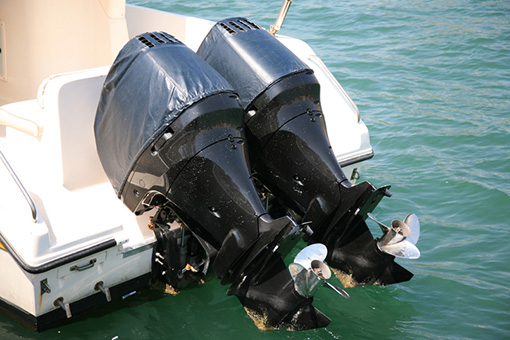
Join Our Newsletter!
Get community news, buying bargains, and how-to guides at your fingertips.

206-819-2439

Has your engine begun to show signs of aging? Do you have rusty leaks on your manifolds? Are you seeing oil leaking from the seals? Is it harder to start when it is cold? Sometimes, more serious problems occur such as water ingestion, overheating, or damage from striking a submerged object. Or you may simply be seeking to replace it with an engine with superior performance, fuel efficiency, or new technology.
Repowering your boat is not a simple task. There are several things to consider. The time that it will take to repower your boat with a new engine. What other systems will need to be upgraded to accommodate factory warranty specifications? Electrical systems, cooling systems, and exhaust, propeller, running gear.
Take time to repower your boat properly. Repowers are typically done in the offseason. This way, you can do your research without rushing and make deliberate decisions regarding using the best parts possible, at the lowest price available. Also, your technician will have more time to spend with you through the process to ensure that your repower will accomplish your goals in a reasonable time at a reasonable price.
Whether you are a sailboater or a powerboater, your boat value depends, not just on aesthetics, but also on the age of your equipment and how well it has been cared for. For example, a boat may be in pristine condition, but if it had a really old engine in it, the value would be much lower than what it could fetch with a new power plant.
One great example of a perfect repower, was when a client of Access Marine found a Bayliner 2455 in fantastic condition with a blown engine. He repowered the boat and the boat was worth more than the cost of the purchase and repower combined. Value aside, the biggest advantage for him was peace of mind when he fishes offshore since his engine starts every time, runs smoothly, and is fuel-efficient.
Why not rebuild?
Rebuilding your engine is very different from a “repower” (or replacing the entire engine) and each approach has differences that you should be aware of. During a rebuild, a lot of engine parts will be reused if they are considered to still be in good enough condition. With a new engine repower, the exterior components of the engine are replaced with new parts, including alternators, starters, exhaust manifolds, wiring, etc.
Also, many boat owners elect to rebuild an existing engine rather than repower because they believe it will save money. However, often the labor that goes into a rebuild is greater than a repower because the parts that are reused need to be refurbished.
In the case of a rebuild, your warranty will be carried by one company, or if you use several companies in the rebuild, the warranty may be carried by all of the companies responsible for rebuilding your engine. These warranties tend to be for 90 days, or in the best-case scenario, one year. However, with a repower, the warranty will be carried by the engine manufacturer. These repower warranties are valid from 1-3 years.
Why use Access Marine for your repower?
Here at Access Marine, we specialize in repowering both sail and powerboats. We have vast experience with diesel engine installations. Often times, a repower will require custom fitting to install the engine to the manufacturer’s specifications. Access Marine closely follows the manufacturer’s installation requirements to ensure the warranty is upheld. During the process, Access Marine upgrades all necessary systems around the engine for proper operation of the new power plant.

- Forums New posts Unanswered threads Register Top Posts Email
- What's new New posts New Posts (legacy) Latest activity New media
- Media New media New comments
- Boat Info Downloads Weekly Quiz Topic FAQ 10000boatnames.com
- Classifieds Sell Your Boat Used Gear for Sale
- Parts General Marine Parts Hunter Beneteau Catalina MacGregor Oday
- Help Terms of Use Monday Mail Subscribe Monday Mail Unsubscribe
Rebuild or repower
- Thread starter redlegmsg66
- Start date Jul 6, 2023
- Forums for All Owners
- Engines and Propulsion
redlegmsg66
I have a Perkins 4.236 hours unknown multiple leaks still runs ok. Same with Borg Warner Velvet Drive transmission. Installed in boat 1975 neither have been rebuilt previously. My options are rebuild it in my garage Purchase remanufactured engine and transmission Repower with new engine and transmission. Cost is a concern however safety and reliabilty are number one. Give me your thoughts as well as your experiences with the three options. Thanks
A story of the engine that could.... Then didn't…NOW DOES
Diesel Specialist 920-347-0880. 2264 mid valley drive, de pere, wis do not compare to john's nightmare in above thread. must have been a retired carnie they, diesel specialist, keep farm machines running all over the mid west. first class operation. boat engines too. one look at their machine shop and you will understand. top shelf operation. they do all my work, and have since 1980. major, and minor. work gets done in a timely fashion. drive over and discuss your needs. good people, highly skilled. joke: what do you know if your perkins engine has stopped leaking oil? A: your engine is out of oil modern replacement seals seem to work better. 50th year with my alden this season. 1966 perkins 107, velvet drive tranny. the boat goes sailing every day in the season. it fired up this morning, running just fine family has been sailing out of sturgeon bay since 1853
Thanks for the info. I am familiar with Sturgeon Bay and know Depere fairly well. My wife grew up there. I will definitely give them a call
Tally Ho said: Read this saga… A story of the engine that could.... Then didn't…NOW DOES I have been thinking about how to write this tale of woe. A couple of my friends here at SBO have commented about the drama I have been experiencing with the Perkins 4.107 engine in my 48 year old boat. While it came to me with evidence of abuse, with some normal maintenance and minimal fixings... forums.sailboatowners.com You don’t mention if the engine and trans are working now or if you are having issues. Greg Click to expand
Get estimates for both rebuilding and replacing. Beta engines are based on a Kubota block and are popular choices for repowering. Another choice would be a Nanni diesel. Same Kubota blocks as the Betas marinated marinized by Nanni and painted Blue. Last winter I purchased a 110hp Nanni from Hansen Marine in Marblehead for about $25K. In 2021 I priced a 33HP Yanmar, it was about $20k. , I only offer these as price points in your considerations. I found Hansen Marine a very easy company to deal with.
a compression test will be telling if that's good, fuel delivery is next. fuel pump rebuild-injectors rebuilt oil leaks: seals and gaskets can be replaced. there are high quality options available diesel specialists can come to the boat. they can tell you what you'll need. next: motor mounts, new is good they do wear tranny: it's an easy rebuild when they are not blown up. mine was sent to chicago the last time. all good to go. the clutches do wear in time. preventive maintenance is a consideration. D.S. is a perkins dealer along with 10 other diesel companies they represent. they can do whatever you need. you can see them from 41. next to the BMW motorcycle dealer. yeah, i have a 2004 r1150r.
- This site uses cookies to help personalise content, tailor your experience and to keep you logged in if you register. By continuing to use this site, you are consenting to our use of cookies. Accept Learn more…

Download Our Repower Guide for FREE!
Repowering your boat is a major decision and there are several things to consider. We’ve collected some important information to help guide you through this decision and process. Connect with a certified YANMAR dealer or distributor when you are ready to make the next steps in your repower project.
Sign-up to receive the latest information from YMI about new products, services, and updates.
Dealer Locator
YANMAR’S extensive global service and parts network spans 130 countries and over 2100 locations.
We’re here to help and would love to hear from you. Contact us with inquiries, comments, and feedback.

Elige tu idioma
Choisissez votre langue, velg ditt språk.
Nederlandsk
Portugisisk
Välj ditt språk
Portugisiska
- MarketPlace
- Digital Archives
- Order A Copy


Repair, rebuild or repower
When you have an older boat like we do — a 1987 Moody 422 sloop — and you’re living aboard and cruising it full time, the process of repairing and replacing gear is part of life. We’ve replaced sails and electronics over the years. We bought a new dinghy and replaced the outboard. We’ve put in a new complement of batteries twice already and upgraded wiring and solar panels. We’ve replaced yards of line and pounds of hardware. But now we are facing a very tough decision — the main engine.
We consider our main engine a vital piece of safety equipment. Yes, we are a sailboat and we try to sail as often as we can, both because we enjoy it and it saves fuel costs. But there are times when running the engine is critical: when you know bad weather is approaching and you can motor your way clear; when a narrow atoll entry requires an engine that will get you through the pass safely; and simply working your way into an anchorage and setting the hook. For all of these situations, a solid engine is essential.
Our engine is a 50-hp Perkins 4-108 built in 1987. We aren’t quite certain how many hours it has because when we purchased the boat in 2004, there was no hour meter and we’re the third owners. We put an hour meter on and have added almost 3,000 engine hours since we’ve owned it. Over the last three years it seems we have been putting more and more dollars into repairs.
Now we have a few more issues looming large and we are asking ourselves the big question: “Do we continue to repair it, rebuild it, or do we bite the bullet and buy a new engine?”
Repair You do this whether it’s a new motor or a good old workhorse engine. Things break or wear out and need to be replaced. We have lots of spares for our engine aboard and Michael is capable of doing most of the repairs himself. It’s when the big issues come up that we bring in the experts — and in remote places this is often difficult (if even possible) and usually expensive.
Getting parts for an engine that is 28 years old can sometimes be an issue. We checked on a new starter and the only way to be certain it would be the right one was to send our old one in to the parts company. We were in New Zealand at the time and dealing with a U.S. supplier, so the cost of shipping back and forth would have been both very expensive and time consuming. We opted to have the starter rebuilt at almost the same cost as a new starter minus the shipping. We are still not certain the rebuild was done correctly.
We looked at all the major repairs we have done over the years as part of our analysis for this “big” question.
Before leaving, we put on a new transmission and damper plate. In the last six years of cruising we have done the following major repairs on our engine: replaced fuel lift pump; new main rear and front oil seal; rebuilt fuel injector pump; injectors serviced; new high pressure fuel lines; new motor mounts; new raw water pump; two new alternators; heat exchanger core cleaned and tested; and exhaust mixing elbow replaced twice.
When these repairs are amortized over all the miles under the keel, this has not been too extreme. One mechanic we trusted in the U.S. once told us, “A good diesel engine will corrode out before you wear it out.” And though the repairs hurt every time we clunked down a thousand of our favorite American dollars (it always seems to be at least $1,000), it is a chunk spread out over time. It may be $1,000 at a time — but that may be easier to swallow than a lump sum of many thousands to rebuild or buy a new engine. Repairing usually means only a short time out of commission to do these repairs.
Looking back over the six years of cruising, having tracked each dollar we spent, we spent around $8,000 on parts and mechanics for the main engine alone. That does not include all the spare parts that we used on it that we already had on board before departing Florida in 2009. It also does not include the consumables like oil or filters, which we would use on a new or old engine. Amortized over the six-plus years of sailing, we are probably spending about $1,500 a year on main engine repairs. Would investing in a new engine cost us less annually over the long run, and would we see those savings or will the next boat owner reap the benefits?
Peace of mind is probably the biggest concern with this “repair” option. As we write this, we are at a very remote island in the Banks Islands group of Vanuatu. There are no repair facilities or parts around — the closest is a plane ride away. The engine has a cooling water leak and a small diesel leak on the injector pump. We don’t want to mess around with the engine too much here, but we still have a long haul to get back to New Zealand and don’t want to do that passage with a dodgy engine. So we will have to invest some repair dollars in hopefully solving these problems while still in either Vanuatu or New Caledonia.
Rebuild The Perkins 4-108 is a solid engine. Parts are still relatively available, though the places to get them are becoming more limited with each passing year. Mechanics can usually be found in most locations that know this motor. So, our second option is to have a total rebuild, top to bottom, of our existing engine.
We carry lots of spares for this engine, so a rebuild would save us having to buy new spares for a newer and different engine. Michael has worked on this engine quite a bit and knows it pretty well so there would be no new learning curve for him.
The key to the rebuild will be finding someone who can do the job so we have confidence in the work. Someone we can trust. We’ve had both good and bad experiences with mechanics over our six years of cruising. Finding someone willing to take on this project who is capable of quality and timely work will be the single largest challenge in this option.
The cost of this more major “repair” is also a factor. We estimate that the cost will be around $10,000 for a major overhaul. That is not a hard number, just an estimation for our thinking process. Of course, the price will adjust after a diagnostic of the engine determines how deep we need to go. Before we make a firm decision, we need to get more accurate numbers, then add 25 percent for the “unforeseen” extras. We will also have to be out of the water and out of commission. Because the boat is our home, living aboard during a major rebuild will also be tough. There may be additional costs with finding a home away from our floating home.
A well-done rebuild should give us the peace of mind to head into even more remote locations. The key will be finding the right person to do the job while in New Zealand — there at least we won’t have a language issue complicating the process.
Repower This is the big pill to swallow. It is a big chunk of money in one fell swoop. We are on a cruising budget and that is always a hard thing to accommodate.
Though there are never any guarantees, we know that with a new motor we would feel more confident in remote locations. Plus the new motor will come with some warranties. The good news is we could also upgrade our horsepower. Currently, we feel slightly underpowered with the 50-hp engine. We probably could also save some money on fuel and oil with a more efficient power source. The updated engines are also better equipped to handle some of the newer low-sulfur and bio-diesels that seem to be more prominent — and often the only option — in various locations. We most likely will also save a few pounds of weight aboard with a more efficient newer engine.
The hardest part will be fitting a new engine on the existing engine room platform. Though engines are now smaller and more efficient than 28 years ago, the boat was constructed with the braces and mounts for our current Perkins engine. The good news about a replacement motor will be the opportunity to totally clean out the engine room, repaint it and make the most efficient use of the space.
Besides the cost of the actual new engine, there are many more costs associated with a repower. New fuel lines, hoses, wiring, shaft, an exhaust system and, of course, spares. New belts, filters and backup parts will need to be added to the spares locker. Add the cost of the haul-out, shipping, finding a place to lie our heads while the work is being done and the cost of a mechanic, and the price tag gets mighty hefty. What is a reasonable price for more power and peace of mind?
Again, our price on the engine is a rough estimate; as we get closer to making a decision, we would have a firm negotiated price tag. It’s hard to get prices in the remote islands! We spoke with one mechanic and he said to double the price of the engine to include the installation. Of course this is most likely to have the mechanic do all the work. In our case, Michael would do a lot himself and use the mechanic for his expertise. So perhaps we wouldn’t have to quite double the price.
Are we overreacting with even thinking about repowering? We repowered our last boat and felt like it was a mistake. We sold the boat within a few years of repowering. The new owners got the benefit. We got the bill.
We know this boat will be our home for as long as we decide to continue cruising. We are still enjoying the experience and plan on a few more years. After we’re done cruising, we’ll sell this boat and get something smaller. We decide annually if we’ll continue cruising and if so, where we’ll go. If we stay in the South Pacific region, making the run between New Zealand and the islands, the “repairs” options makes the most sense. If we want to venture into Indonesia and beyond, we would be more confident with at least a rebuild. Or should we just go ahead and upgrade with a newer model engine? We know we won’t get the money out of a new engine when we sell, but perhaps it will speed the sale.
Barbara Sobocinski and Michael Hawkins live aboard their Moody 422 sloop Astarte . Since leaving St. Petersburg in February 2009, they have explored the Caribbean and the Pacific.
By Ocean Navigator

- Center Consoles
- Dual Consoles
- Motoryachts
- Sport Cruisers
- Tenders & Ribs
- U.S. Atlantic
- Engine Buyers Guide
- Electronics
Repowering an Old Boat

Many consumers are choosing not to wait six months to two years to take delivery of a new boat.
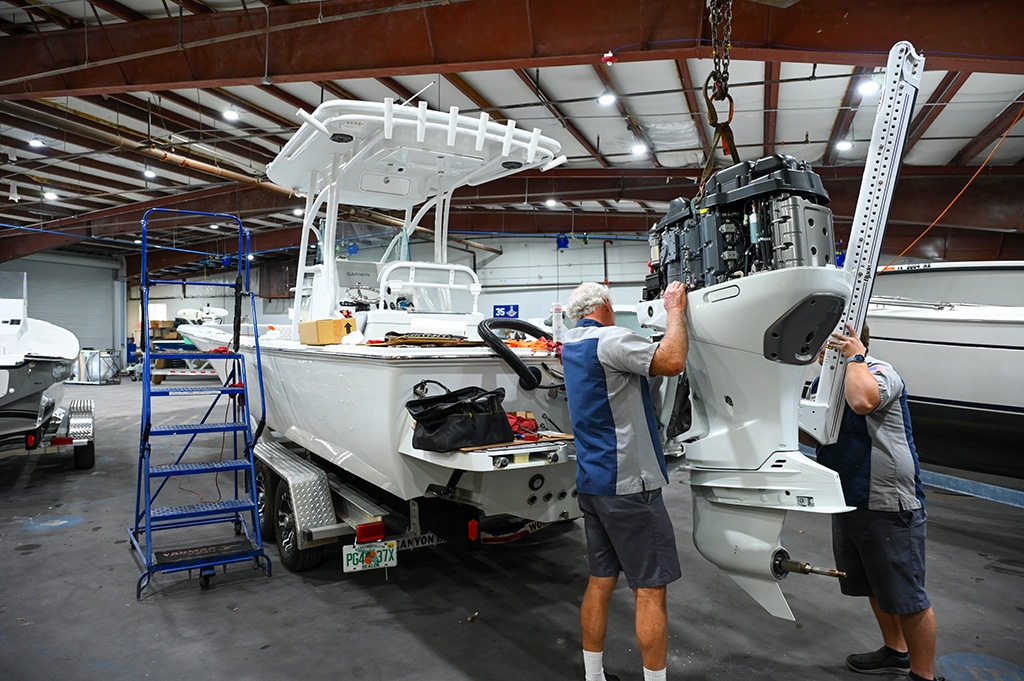
Recommended
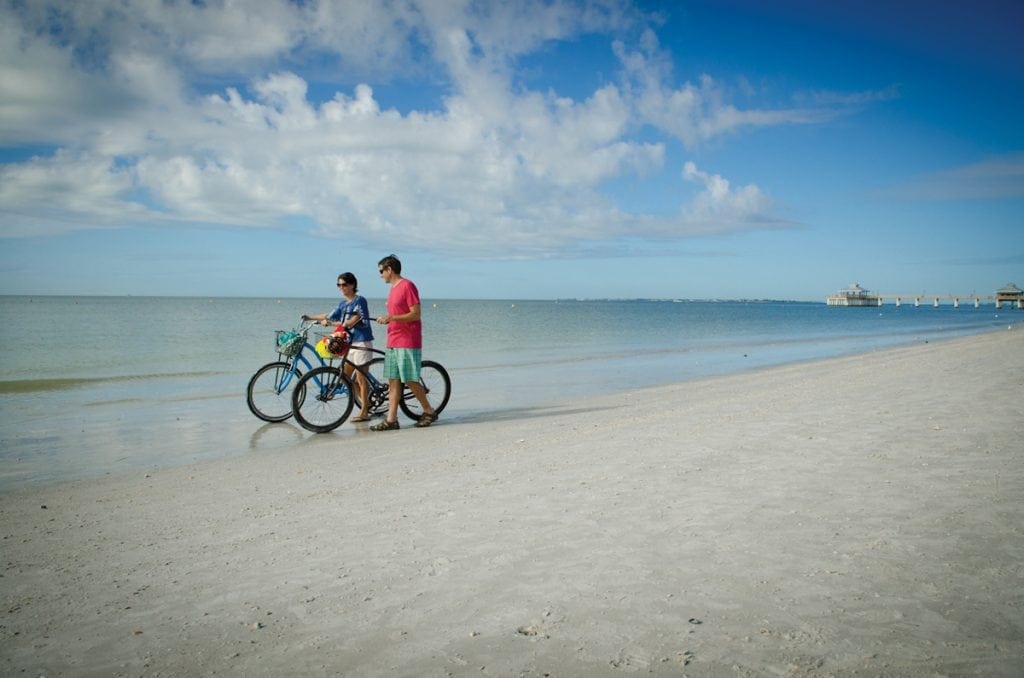
Six Spots to See in in 2019
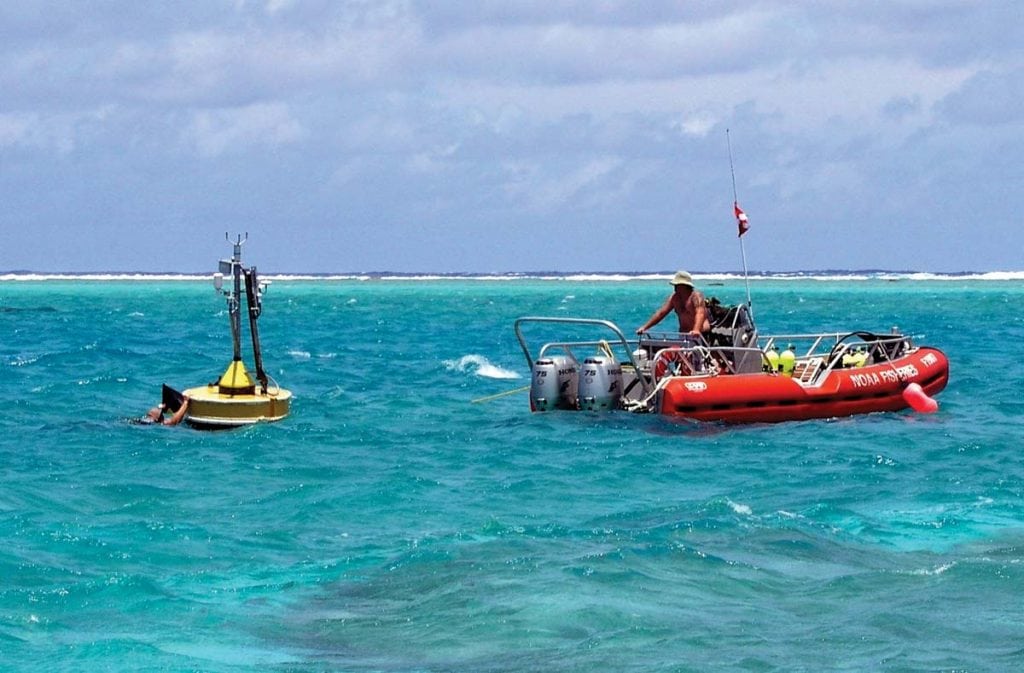
Free Weather Widgets
Don't miss it.

Celebrate the Water’s Elegance with Hinckley’s 30th Anniversary Picnic Boat

7 of the Best Available Navigation Apps for Boaters

Fort Lauderdale’s Exclusive Over-the-Water Estate: A Nautical Haven

The Bull Keeps Running. What Does The Strength Over the Last 60 to 120 Days Mean?

Marlow Yachts 62E: Custom Luxury Meets Seafaring Excellence

How To Make Surprisingly Delicious Minimalist Meals
- Privacy Policy

1591 E. Atlantic Blvd, 2nd Floor Pompano Beach, FL 33060 Office: +1 (954) 522-5515 Fax: +1 (954) 522-2260 Contact us: [email protected]
Email address
© 2024 Southern Boating Media
- 2024 BOAT BUYERS GUIDE
- SHALLOW WATER FISHING
- Email Newsletters
- Boating Tips
- Boating Safety
- Electronics
- Best Marine Electronics & Technology
- Baits & Lures
- Fishing Tackle
- Fishing Travel
- Conservation
- Fishing Knots
- Women in Fishing
10 Questions to Answer Before Repowering an Outboard Boat
- By Jim Hendricks
- Updated: July 16, 2019
The thought of purchasing a new fishing boat always sounds tempting, but for many would-be buyers, the timing might not be right. If the propulsion system on your current boat is growing tired, however, the timing might be right for fresh horses.
Repowering a boat is a great way to extend the life of a fishing machine. Yet there’s more to consider than just bolting on new engines . You need to figure out how much it costs to repower your boat, and weigh a number of additional options. Here are 10 questions to ask yourself or your dealer, with answers offered by outboard experts.
Should I change horsepower?
“Look at the boat’s capacity plate to learn the maximum rated horsepower,” says David Meeler, marine-product information manager for Yamaha Outboards . “That’s the horsepower you should put on your boat during a repower, no matter what you had before.”
Boats perform at their best with the maximum rated horsepower, Meeler points out. Plus, you’ll often get the best fuel economy because the engine is not struggling. “Just because you have the horsepower doesn’t mean you have to use it all of the time,” Meeler adds. “But it’s nice to have it handy when needed, such as when powering over a big wave.”
Should I change engine brands?
The biggest reason to change is unhappiness with your current brand, be it related to performance, local dealer service or warranty terms. If you’re satisfied with all three, there’s little reason to change brands. If you do plan to switch, check out the local dealer and make sure you’re comfortable with the available service, the product and the warranty.
Should I change the number of outboards?
Changing the number of outboards is not a good idea, says Evinrude product manager Jason Eckman. “It’s very complex and involves lots of fiberglass work to prep the transom for such a drastic switch,” he says. “Also, adding another outboard can add too much weight to the stern, or the transom might not have enough width or structural support to accommodate another engine.”
If you want to go from a single to twins for offshore safety, that issue is hardly relevant today. “Reliability of today’s outboards is such that you should not be afraid to go 30 to 40 miles offshore with a single outboard,” says Meeler.
Should I get new controls and instruments?
It’s a good idea to update everything — steering, throttle and shift, cables, electrical harnesses, battery cables, and instruments, says Larry Teeling, product category manager for Mercury Marine . Consider the steering. “Why struggle with an old, worn steering system with your new outboard?” Teeling asks. Similarly, a new engine with old controls and gauges will only dampen your experience.
Digital instrumentation has also come a long way in the last 10 years, Teeling says, offering information that old gauges could not provide, such as fuel consumption and best speed for fuel efficiency.
Should I change to another outboard technology?
The technology aspect of a repower has become less impactful over time, contends Teeling: “In the early 2000s, four-stroke outboards were associated with being heavier and requiring more maintenance than two-strokes. That’s no longer the case.” As two- and four-strokes approach parity in terms of weight and maintenance, the key is to select an outboard technology that makes your boat perform the way you want and maximizes its value, says Teeling.
Can I add a joystick control as part of a repower project?
Joysticks offer intuitive, slow-speed steering, allowing anyone to dock a boat like a professional captain. While original-equipment manufacturer systems with joystick controls, such as Yamaha’s Helm Master and Mercury’s Outboard Pilot , are not available for aftermarket installations, SeaStar Solutions Optimus 360 power-steering system (which includes a joystick control) can be added to an existing boat.
The decision to add it as part of a repower project boils down to three factors, says David Greenwood, product planning manager for Suzuki Marine . “First you need to have multiple outboards, as such systems won’t work with a single engine,” Greenwood points out. “Secondly, consider your experience level and the size of your boat. If you lack experience in docking a relatively large boat — say over 30 feet in length — in tight quarters, a joystick can be very helpful.”
The third factor is the price, Greenwood says. An Optimus 360 system can range from $18,000 to $22,000, plus installation costs. “Is the benefit worth the investment?” Greenwood asks. “Only the boat owner can answer that.”
Should I install new fuel-system components?
The short answer is a resounding yes, says Yamaha’s Meeler. “I recommend that boaters replace all of the boat’s fuel hoses with new Coast Guard-approved, ethanol-resistant hoses with every repower, if not more often,” he says. “This is also the time to make sure you have a 10-micron water-separating fuel filter for each engine.”
If you’re upgrading to higher horsepower, check the engine manufacturer’s specifications to ensure that you install a fuel hose and fittings with inside diameters (e.g., ⅜ inch) sufficient to sustain the engine’s fuel needs at wide-open throttle. A fuel line or fitting that’s too small can starve the engine of fuel at the upper rpm range, not only hampering performance, but also leaning out the fuel-to-air ratio, a condition that can damage an engine.
Will my old battery system be sufficient?
The answer depends on which engine you choose. Some outboards with integrated power-steering systems and high-pressure fuel-delivery systems may require a more robust battery system. Check the engine manufacturer’s specifications or ask your dealer.
“You should also replace the old battery cables with fresh ones,” says Evinrude’s Eckman. Old cables might be corroded inside, causing too much resistance, lowering the voltage delivery, and increasing amp draw to excessive levels.
Which color should I choose?
Evinrude, Mercury and Suzuki each offer color choices in their outboard lineups. Yet color is mostly cosmetic, says Mercury’s Teeling: “Matching the color of engines to the boat has become quite popular.” In warmer climates where water spots develop quickly, white outboards are more popular, says Suzuki’s Greenwood. “White does not show water spots as much as a darker outboard will,” he observes.
What should I do with my old engine?
You can advertise your old engine for sale, but your main stumbling block will be moving a large, heavy outboard off your boat and onto the buyer’s boat. This is where a dealer can help, according to Sara Pines, public relations director for Honda Marine . “Consult with your local dealer about your old engine,” Pines says. “Often, they are willing to assist you in the selling of the old engine.”
Finally, the most important question to ask yourself is, “How long do I plan to keep my boat?” The cost of new power, related upgrades and installation charges can range from $10,000 to $80,000 or more. “For that kind of investment, plan on keeping your current boat for the next 10 years at least,” says Evinrude’s Eckman.
Yamaha’s Meeler echoes that sentiment. “The first thing I ask anyone who comes to me with repower questions is, ‘How much do you love your boat?’” he says. “The answer will help you determine what the future holds — new power or a whole new boat.”
- More: Boat Engines , fishing boats , outboard motors
What’s Good Fuel Economy for a Fishing Boat?
Yamaha releases new 350 horsepower outboard, supersize center-consoles expand angling horizons, things to look for in a jig-and-pop boat, protect the blue: faces of conservation in the florida keys – lower keys, protect the blue: faces of conservation in the florida keys – key largo, panama’s topwater yellowfins, maryland cancels trophy striped bass season.
- Privacy Policy
- Terms of Use
- Cruising World
- Florida Travel + Life
- Sailing World
- Salt Water Sportsman
- Sport Fishing
- Wakeboarding
Many products featured on this site were editorially chosen. Sport Fishing may receive financial compensation for products purchased through this site.
Copyright © 2024 Sport Fishing. A Bonnier LLC Company . All rights reserved. Reproduction in whole or in part without permission is prohibited.

Boat Models
Sample of boats repowered with beta marine engines.

Bermuda 40 (Hinckley) Engine Repower / Replacement
Displacement: 6,500 lbs
Builder: Albin

ALBIN 27 Engine Repower / Replacement Copy

CATALINA 30 Engine Repower / Replacement
LOA: 29.92 ft / 9.12 m
LWL: 25.00 ft / 7.62 m
Displacement: 10,200 lbs / 4,627 kg
Builder: Catalina Yachts (USA)

CAPE DORY 30 Engine Repower / Replacement
LOA: 30.21’
LWL: 22.83’
Displacement: 10,000 lbs
Builder: Cape Dory Yachts (USA)

WESTSAIL 32 Engine Repower / Replacement
Displacement: 19,500 lbs
Builder: Westsail Corporation

CATALINA 34 Engine Repower / Replacement
LWL: 29.83’
Displacement: 11,950 lbs

TARTAN 34C Engine Repower / Replacement
LOA: 34.42’
Displacement: 11,200 lbs
Builder: Tartan Marine

Voyage 440 Catamaran Engine Repower / Replacement Copy

CATALINA 36 Engine Repower / Replacement
LOA: 35.58’
LWL: 30.25’
Displacement: 15,000 lbs

PEARSON 365 Engine Repower / Replacement
LOA: 36.42’
Displacement: 17,700 lbs
Builder: Pearson Yachts

TARTAN 37 Engine Repower / Replacement
LOA: 37.25’
Displacement: 15,500 lbs

CABO RICO 38 Engine Repower / Replacement
LWL: 29.25’
Displacement: 21,500 lbs
Builder: Cabo Rico

PEARSON 39 Engine Repower / Replacement
LOA: 39’ 3”

PASSPORT 40 Engine Repower / Replacement
LOA: 40.67’
LWL: 33.42’
Displacement: 22,771 lbs
Builder: Passport Yachts Inc.

MORGAN 41 Out Island Engine Repower / Replacement
LOA: 41.25’
Displacement: 24,000 lbs
Builder: Morgan Yachts / Catalina Yachts (USA)

CSY 44 (Mid-Cockpit) Engine Repower / Replacement
LWL: 36.33’
Displacement: 38,000 lbs
Builder: CSY (Caribbean Sailing Yachts)
- VISIT STORE PROFILE
- Shop Boat Inventory
- Shop Off Road Inventory
- Schedule Service

Bass Pro Shops®/Cabela's® Boating Center™ is the largest volume boat retailer in the world. We are the home of America’s Favorite Boats, the world’s largest Mercury® outboard retailer and a proud retailer of TRACKER OFF ROAD™ ATVs and UTVs.
- SUN TRACKER®
- TRACKER OFF ROAD®
- Boat Accessories
- Off Road Accessories
Our Locations
Bass Pro Shops®/Cabela's® Boating Center is more than just a boat dealer—we’re here to help make all your boating and off-roading dreams come true. Whether you’re shopping for a new boat or ATV, looking for parts or service, want to stock up on gear or just want advice, we have you covered. In addition, we’re also here for your repower needs.
- Choose Boating Centers
- Toyota Partnership
- Portable Motors
- Apply for Financing
- Ready to Buy?
- Value Your Boat Trade-In
- Insure Your Vehicle
New to boating and want more insight into the sport? Want to learn how you can help protect the environment while off-roading? Need info on fishing with kids? As your premier source for all things boating and off-roading, we are happy to help answer all your questions in our Learning Center blog.
- Learning The Ropes
- Do’s and Don’ts of Towing A Boat On The Water
- Choosing Watersports Towing Hardware
- First Aid For Boaters
- 10 Weird Lures You Should Try
- Holiday Gift Ideas For ATVers
- 10 Winter ATV Safety Tips
- 10 Ideal Tasks For Off-Road Vehicles
- Best Apps For Offroading
- Replacing Trailer Bunks
- How To Fix It
- Meet The Pros- Tim Thompson
- Mercury Master Certified Technicians
- Meet The Pros-Jody Graves
- Find The Boat Brand For You!
- Freshwater Fish Quiz
- Saltwater Fish Quiz
- Boating Safety Quiz
Repower Motors

Your Mercury® Outboard Repower Headquarters
Since 1939, Mercury Marine has made world-class outboard motors to provide boaters the trusted power they need to pursue any on-the-water activity in any conditions. Eighty years later, the Mercury lineup runs from portable 2.5-horsepower outboards to 350-horsepower powerhouses. Every motor is designed and built to be extremely fuel efficient, handle amazingly and last for years—all backed by the best warranty coverage in the industry.
Call your nearest Bass Pro Shops or Cabela's Boating Center for pricing and availability.
General sales, best selection. best prices..
Bass Pro Shops®/Cabela's® Boating Center is the world’s largest Mercury outboard dealer. We offer a variety of motors to fit virtually any need, from easy-to-carry ProKicker outboards for jon boats to huge outboards for offshore fishing boats. Whatever you need, we’re sure to have it—and at a price that can’t be matched by anyone else.
In fact, when you see a Mercury motor advertised in our retail mailers and catalogs, you can rest assured that you’ll get it for even less in our stores.
Certified Installation & Service
All 130-plus Bass Pro Shops/Cabela's Boating Center locations have a POWER PROS service center. In addition to providing a wide range of repair and maintenance services to keep your current motor in tip-top shape, our factory-trained technicians offer certified installation for new outboards! So, if you purchase a new outboard, you’ll be able to have it completely installed on-site! And they’ll be here for all your maintenance needs down the road.
Mercury-Trained Sales Consultants
Bass Pro Shops/Cabela's Boating Center sales consultants receive training from Mercury Marine to help them become experts on the outboards. They’ll be able to help you select the best engine for your needs and boat.
*Financing on loose motors not available in Louisiana, Montana, West Virginia, Alaska or Rhode Island. Sale amount required to finance must be $5,000 or more.
We're everywhere you need us to be.
- Shop By Category
- Find A Location
- TRACKER OFF ROAD™
- Our Services
- Mercury Outboards
- Find a Location
- Learning Center
If you are using a screen reader and are having problems using this website, please call 1-800-227-7776 for assistance.

IMAGES
VIDEO
COMMENTS
Many of these engines were designed as truck or tractor motors, then retrofitted for marine use. The question facing you now is: Should you rebuild the existing engine? Or repower with a brand-new engine? Let's start with the cost of repowering. "You're talking probably between $12K and $16K for a 30-footer, and $18K to $22K for a 40- to ...
Power-to-weight ratios do matter: The heavier the plane's engines, the more thrust it needs to gain altitude. The whole idea is to find the ideal balance. Simply replacing your 25- or 30-horsepower auxiliary engine with a 75-horsepower turbocharged model might sound good, but there's more to consider than pure muscle.
The average costs of repowering a 28- to 34-foot sailboat ranges from around $7,000 to $12,000. This doesn't allow for V-drive transmissions, which always add to the labor cost because of the extra time involved. Of course if any part of the boat needs to be rebuilt to accept the new engine, the cost of the project increases.
Electric repower. Thread starter Guan; Start date Jul 15, 2021; Forums. Forums for All Owners ... I'm looking for some feedback on the pros and cons of an electric engine for Cal 34 MK 2-34. ... As yet the most compact and reliable source of power per pound is diesel for a sailboat. At least in my examination of this auxiliary motor concept for ...
The complete package propelling Rock Proof's ePro 1760R, a boat we tested in Boating 's March 2023 issue, utilizes Elco's EP-50 and 20 kWh of lithium batteries; it sells for about $22,500. The Torqeedo Deep Blue 110i is equivalent to a 135 hp internal combustion engine. Courtesy Torqeedo.
Choosing the correct engine to repower your sailboat depends upon several different criteria. Utilize the Beta Marine experts that are ready to help. (252) 249-2473. Toll Free: (877) 227-2473 ... There are lots of variables to consider when making a decision, such as the boat, engine bed, and how you plan to use the boat. ...
Repower with YANMAR 6LFs. Certified YANMAR dealer Motonáutica Balear, Mallorca, completes the installation of two YANMAR 6LF530 diesel engines on Magnum Marine 40 motorboat Adriana to raise performance to a new level. Repowering with a new, technologically advanced YANMAR engine will instantly breathe new life into your boat.
Let's look at two of the important emission aspects while repowering your boat: 1. Compliance with emission regulations: Most often when your vessel is under EPA regulations, you can repower your boat using an engine that has an equivalent or better emission level with the engine being replaced. Meanwhile, emission compliance often has local ...
Generally, repowering a boat improves the power-to-weight ratio (making your boat easier to handle), maximizes speed and power, and offers a more enjoyable boating experience overall. 2. Extend the Boat's Lifespan. A properly-maintained boat engine lasts many years - extending your time on the water.
With a new engine repower, the exterior components of the engine are replaced with new parts, including alternators, starters, exhaust manifolds, wiring, etc. Also, many boat owners elect to rebuild an existing engine rather than repower because they believe it will save money.
We Repower Boat Engines with Ease. Extend the life of your boat with an engine repower. Boats are designed to take a beating. A boat's engine is not. A well-designed hull can last for decades, well past when most engines begin to fade out. If you love your boat but the engine's a goner, repowering is an affordable option.
Repower with new engine and transmission. Cost is a concern however safety and reliabilty are number one. ... keep farm machines running all over the mid west. first class operation. boat engines too. one look at their machine shop and you will understand. top shelf operation. they do all my work, and have since 1980. major, and minor. work ...
Boats between 10,000 and 14,000 pounds need the 20 hp Beta Marine engine. Boats between 14,000 and 18,000 pounds require the 28 hp Beta Marine engine. The above Sailboat engine repower diesel engines are available with Atomic 4 engine mount spacing at no additional cost. This precludes the need to modify the engine bed or stringers to ...
Repowering your boat is a major decision and there are several things to consider. We've collected some important information to help guide you through this decision and process. Connect with a certified YANMAR dealer or distributor when you are ready to make the next steps in your repower project.
Ocean Navigator February 29, 2016. When you have an older boat like we do — a 1987 Moody 422 sloop — and you're living aboard and cruising it full time, the process of repairing and replacing gear is part of life. We've replaced sails and electronics over the years. We bought a new dinghy and replaced the outboard.
Volvo Penta offers universal Repowering kits for engines with shaft, which make it easier to replace any engine brand with a Volvo Penta D1 or D2 engine. High quality. Lower cost. Choosing a remanufactured engine offers the same unbeatable quality as our new engines, at a more competitive price. The Volvo Penta Exchange system gives you access ...
A repower might require more than a new engine, depending on the boat's age, and that's where the repower center can guide the customer. Boats that are candidates to get repowered are typically between five and 20 years old. "It could be as simple as unbolting their current engines and putting new engines on or it could be a complete tear ...
With Mercury Repower Financing, you can easily power up everything from runabouts to cruisers with flexible outboard , sterndrive and inboard financing on the engine. You can also choose to finance the entire engine package (rigging, gauges, controls and labor). Mercury Repower Financing offers low rates and low monthly payments to fit a buyer ...
Repowering a boat is a great way to extend the life of a fishing machine. Yet there's more to consider than just bolting on new engines. You need to figure out how much it costs to repower your boat, and weigh a number of additional options. Here are 10 questions to ask yourself or your dealer, with answers offered by outboard experts.
Photo by Paul Fujita for Boat Trader. The Right Reasons To Repower. Repairing an older boat or wanting more pick-me-up are just two reasons among many when considering purchasing a new outboard for an existing boat. Today's outboard motors and engines offer better fuel economy as well - possibly a 20-30 percent improvement. That means a ...
Our Repower Center experts will help you pick the perfect Mercury engine to deliver the experiences you want. They can also help give your old boat a new-boat feel with upgraded controls, gauges, electronics and other accessories.
Sample of Boats Repowered with Beta Marine Engines. Filters. Filter By Reset. Apply. Filters. ALBIN 27 Engine Repower / Replacement. LOA: 27' LWL: Displacement: 6,500 lbs. Builder: Albin. CATALINA 30 Engine Repower / Replacement ... Engine Repower / Replacement.
Since 1939, Mercury Marine has made world-class outboard motors to provide boaters the trusted power they need to pursue any on-the-water activity in any conditions. Eighty years later, the Mercury lineup runs from portable 2.5-horsepower outboards to 350-horsepower powerhouses. Every motor is designed and built to be extremely fuel efficient ...